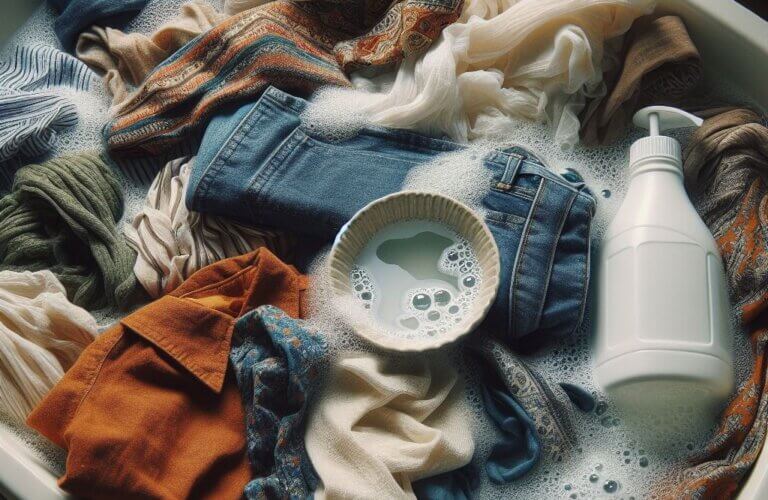Does Flannel Shrink in the Wash? 5 Simple Steps to Care for Your Flannel
Flannel is a beloved fabric for its softness and warmth, making it ideal for cozy shirts and blankets. But its delicate nature also means it requires some special care. The big question many flannel owners have is: does flannel shrink in the wash?
The short answer is – yes, flannel can shrink easily if not washed properly. The amount of flannel shrinkage depends on the quality of the fabric, but cheap flannel shirts are particularly vulnerable. However, by following some simple flannel care tips, you can successfully wash flannel clothes without significant shrinkage or damage.
In this comprehensive guide, you’ll learn:
Table of Contents
What Is Flannel and Why Does It Shrink?
Flannel refers to a soft woven fabric made from wool, cotton, or synthetic fibers with a lightly brushed finish on one or both sides. This brushing process raises the fibers to give flannel its signature cozy feel and look.
The loose weave and delicate raised fibers of flannel make it prone to shrinkage when agitated and exposed to high heat. The fibers mash down and the fabric loses shape. Cheap flannel is often poorly woven with inferior fibers, making it especially vulnerable to dramatic shrinkage.
Key reasons flannel shrinks:
- Loose weave allows fibers to shift and fabric to lose shape
- Gently raised fibers get compressed under heat and agitation
- Inferior cheaper fibers felt more easily
- Pre-washing and preshrinking are often not done
So if you toss your favorite flannel shirt into a hot wash and dryer, you may find it shrunken and misshapen. By understanding how to properly care for it, you can keep your flannel looking and feeling great for many years.
Should You Wash New Flannel Clothes Before Wearing?

Yes, brand-new flannel shirts, sheets, or other items should be washed before first wear. Flannel shrinkage mainly happens in the first few washes until the fibers settle into their new positions.
So pre-washing ensures any initial shrinkage won’t happen while you’re wearing and loving the item! It helps set the shape, size, and softness – yielding years of cozy flannel enjoyment.
To prewash flannel:
- Wash separately in cold water with gentle detergent
- Air dry or machine dry on low temp
- Repeat wash & dry 1-2 more times
If your new flannel shrinks slightly while prewashing – no worries! Better it shrinks now than later. This preshrinking sets the size and texture so future washing causes minimal shrinkage – about 5% at most.
What’s the Best Temperature to Wash Flannel?
Since heat triggers flannel shrinkage, it’s best to use cool or cold water in the washing machine. Hot water causes the fibers to tighten and feel together. For reference, temperatures for washing machines typically are:
- Cold wash = Cold tap water temp, around 50-60°F
- Cool wash = Around 70°F
- Warm wash = Around 80-100°F – Avoid this setting
- Hot wash = Around 120-140°F – Avoid!
So always opt for cold water in the washing machine to prevent unwanted flannel shrinkage. If you have a little extra grime to clean, a cool water wash can also work.
In general, wash flannels in like colors to avoid any bleeding or discoloration in the fibers. Use a mild high-efficiency (HE) detergent and limit it to 1-2 tbsp per load. Overloading detergent can leave residues in the fabric which diminishes softness over time.
And as tempting as it is to toss everything in on quick cycles, opt for a gentle or delicate setting. This slower agitation reduces friction and pulling on the fabric surface. For the best results, wash flannel separately from other heavier clothing which can be rougher on it.
How to Dry Flannel Without Shrinking It
When laundering your favorite flannel shirt or pants, letting it air dry is ideal to prevent shrinkage in the dryer:
Air Drying Flannel
- Gently squeeze out excess moisture, don’t twist or wring
- Lay flat on top of a towel or drying rack, gently smooth into shape
- Allow to fully dry flat before wearing or moving
Air drying avoids heat exposure which could compress the raised flannel fibers. It also lets the fabric relax into its natural shape without any pulling or restrictions.
However, the reality is air air-drying clothing isn’t always realistic with our busy schedules! So what’s the best way to machine dry flannel?
Drying Flannel in the Dryer
You can successfully dry flannel shirts or sheets in the dryer with a few key adjustments:
- Shake items gently and smooth them flat before placing them in the dryer
- Use the lowest heat setting – delicate or low
- If available, choose an air-dry cycle with no heat
- Dry for shorter intervals, checking frequently to prevent over-drying
- Remove immediately when finished and hang up
Take items out of the dryer immediately so they don’t sit bunched up while still warm. The heat releases moisture in the fibers, so leaving the flannel crumpled right after drying allows folds and shrinkage to set.
How to Wash Flannel Sheets Without Shrinking

Caring for flannel sheets brings a few extra considerations with all that surface area! To wash flannel sheets without shrinkage:
- Shake out any crumbs or debris before washing
- Use cool water on a gentle cycle with mild detergent
- Add 1⁄2 cup white vinegar to rinse cycle for softening
- Line dry or dry on low setting, remove promptly
- Stretch slightly and straighten edges while still warm
- Steam or iron while still slightly damp if needed
The vinegar brightens colors and leaves no residue that compromises lush softness. Pull gently lengthwise on the sheets once out of the dryer to realign the weave before the folds set in.
If your flannel sheets feel stiff or crunchy after washing, the detergent didn’t properly rinse away. Re-wash them in clear cool water to return softness. With a little TLC, your flannel sheets will last for years!
Expert Tips to Prevent Flannel Shrinking

Caring for flannel may feel tricky, but doesn’t have to be with these simple pro tips:
1. Read Garment Care Labels
- Follow any special washing instructions from the manufacturer
- Note fabric content – 100% cotton less risky than blends
Labels indicate how the item was pre-treated and the best cleaning methods. If for some reason it says ‘dry clean only” – listen to it!
2. Wash Flannels Inside-Out
- Turning the flannel inside out protects the fabric’s surface
- Minimizes pilling and maintains the brushed nap
- Avoids lint and residue rubbing into the fabric
Save yourself some pilling grief down the road by always washing flannel inside out. It only takes a second and makes a big difference.
3. Use a Mesh Laundry Bag
- Mesh bags allow water flow while protecting fabric
- Stops shrinkage by preventing twisting or bunching
- Useful for delicates like flannel shirts and sheets
Toss flannel sheets or shirts into a mesh bag for washing and drying to avoid any undue stress on the fabric.
4. Skip the Fabric Softener
- Fabric softeners and dryer sheets coat the fabric surface
- Leaves a residue that diminishes flannel’s lush softness
- Also makes lint cling and pilling worse over time
That fresh scented “fluff” you feel with dryer sheets? It’s microscopic plastic coating the fabric that grabs lint. So for super soft and pill-resistant flannel, skip the softener and dryer sheets.
5. Prewash All New Flannel Items
- Shrinkage mainly happens in early washes until fibers settle
- Prewashing ensures fits stay consistent over time
- Also washes away any residues from manufacturing
Don’t take tags off new flannel shirts before prewashing! It will likely shrink slightly at first so better to know before wearing, trimming threads, etc.
How Much Does Flannel Shrink?
If cared for properly, pre-shrunk or high-quality flannel won’t shrink more than 5%, usually less over time. Cheap flannel can shrink considerably more – around 15-20% – in the first hot wash and dry.
In numbers, that means:
- A men’s flannel shirt losing 1⁄2” in length and sleeve
- Flannel sheets shrinking several inches in length and width
The amount of shrinkage depends on 4 key factors:
1. Quality of Flannel
Well-made flannel is tightly woven with either long-staple cotton, merino wool, or microfiber blends. The dense weave makes shrinking harder since the threads lack room to shift and compress.
High-quality flannel features:
- Smooth, even weave with minimal loose threads
- Rich color saturation that feels double-sided
- Weighted drape without being too heavy
- Substantial hand-feel even in lighter weight
Cheaper flannel tends to be loosely woven with low-grade short cotton fibers. These inferior fibers felt more intensely when agitated and heated in the wash. The end product feels thin, pills easily, and shrivels up with too much laundering friction.
Inferior cheap flannel red flags:
- Feels thin, insubstantial, scratchy or sheer
- Fabric pills/balls easily from wash friction
- Loses shape if stretched even gently
- Bleeds excess dye when washed
- Shrinks dramatically right away
So while it may cost a bit more upfront, high-quality pre-shrunk flannel is a worthwhile investment. The added life expectancy from better durability and washability pays off!
2. Temperature of Water & Dryer
Exposing flannel to hot water or high dryer heat allows vigorous shrinking to occur before fibers cool and set into their new positions. But when washed cool and dried on low, shrinkage rarely exceeds 5%.
Heat swells and relaxes fibers so they move more freely to tighten and bind together. Using cold or cool water allows cleaner washing without such extreme agitation.
Likewise, a delicate or no-heat dryer setting minimizes friction heat so shapes can set slowly. The heat differential is around:
- Cold water 55°F
- Cool water 75°F
- Hot water 130°F
So steaming hot washes make that delicate flannel shrink like crazy! Cold washes prevent such traumatic fiber shifts.
3. Frequency of Washing
Beyond the first couple of pre-washings, flannel won’t shrink much thereafter if properly laundered. Only about 5% shrinkage occurs from intermittent cold water washing and low heat drying.
But frequent hot washes create cumulative stress on the fibers, causing shrinking over time. The friction damages surface fibers which strains the weave until it tightens.
So for plaid shirts you hope to keep around awhile, avoid over-washing which deteriorates fabric stability. Spot clean gently when possible between full wash cycles.
4. Quality of Construction
Better constructed flannel resists shrinking because the fibers and weave can better withstand washing friction. Signs of quality sewing include:
- Straight, flat, double-stitched seams
- Cleanly finished hems without loose threads
- Edge stitching to protect from curling or fraying
- Well-aligned print patterns lined up neatly
If the sewing and stitchwork is already irregular or loose upon purchase – you can bet it’ll look pretty sad after its first hot wash.
So upon close inspection, flannel quality and construction predict both its lifespan and shrinkage behavior.
Does Flannel Ever Stop Shrinking?
Yes – after several rounds of prewashing and wearing, cotton and wool flannel fabrics will stabilize at their maximum shrunken size. At this point, the fibers settle into their felted positions and stop shrinking.
This is why prewashing all new flannel garments and fabrics helps “set” the size early on rather than surprising you later. Once the shrinking ability exhausts from those initial aggressive washes the shrinkage tends to stop.
That said if you radically change your washing routine it can trigger more shrinkage. Such as switching from cold to hot washes, or cranking the dryer instead of low temp. So once at the stable shrunken size, handle flannel garments consistently moving forward.
What To Do If Your Flannel Shrinks
So you tossed your trusted flannel in the wash without checking settings, and now have a baby-sized version of the oversized shirt you love. Or maybe everything was washed perfectly yet still shrank. What now?
Here’s the good news – you can stretch shrunken flannel back to near its original size if you act quickly while the fabric is still pliable.
To unshrink flannel:
- Soak the garment in lukewarm water for 5 minutes
- Gently stretch and smooth the fabric back to the dimensions needed
- Lay flat on top of the towel without twisting or bunching
- Once almost dry, iron with steam while gently pulling to the desired size/shape
The key is catching the shrinkage right away before it permanently sets. If too much time passes between shrinking and restretching, the fibers stiffen in their new shrunken shapes.
For best results, immerse, reshape, and steam the fabric within the first hour of noticing the shrinkage. This rebooting of structure works great unless fibers are severely felted and damaged.
Frequently Asked Questions
Still, have some lingering questions about washing flannel? Here’s more answers to common flannel care FAQs:
Does flannel shrink every time you wash it?
- Maybe a tiny bit if using the proper cold water method, but shrinkage exhausts after 4-5 washes
- About 5% shrinkage at most thereafter when following flannel care best practices
How much does 100% cotton flannel shrink?
- Around 15-20% if washed wrong the first time – hot, aggressive drying
- Ideally 5% or less over time if prewashed and laundered properly in cold on delicates
Why does my flannel pill?
- Cheap flannel is loosely woven so washer/dryer friction pulls fibers loose
- Poor-quality fibers break down more easily into lint and balls
- Weaver errors like slipped threads create snagging hazards
- Insufficient rinsing leaves detergent residue that grabs lint
- Fabric softener coating also causes excessive pilling
How to wash wool flannel?
- Select a gentle cycle with cold water
- Use special detergent for delicates, no bleach
- Lay flat or flat dry to prevent stretching
- Steam while still slightly damp for best results
Can you put flannel in the dryer?
Technically yes, but on the lowest temperature possible and removed immediately. Air drying is best to prevent shrinkage issues.
Can flannel go in hot water?
Never intentionally wash flannel in hot 130°+ degree water unless you want a doll’s wardrobe! Stick to cold washes only.
Conclusion: Does Flannel Shrink in the Wash
It doesn’t need to be complicated to keep your flannel wardrobe cozy for the long haul. By avoiding heat, using a delicate touch, and pre-treating new items, you can easily prevent shrinkage.
Choose high-quality pre-shrunk flannel whenever possible for durability. Always check and follow garment care instructions too for best results from laundry to laundry.
With a little TLC, your trusty flannel favorites will last for many seasons staying soft, warm, and perfectly comfy! So this winter as the temperatures drop, break out your favorite flannels with confidence they’ll remain well-loved staples thanks to these tips.








